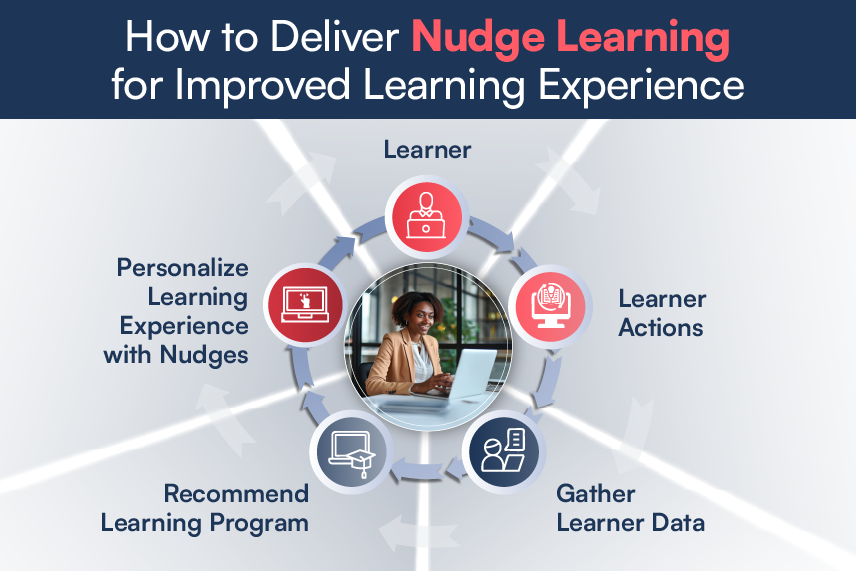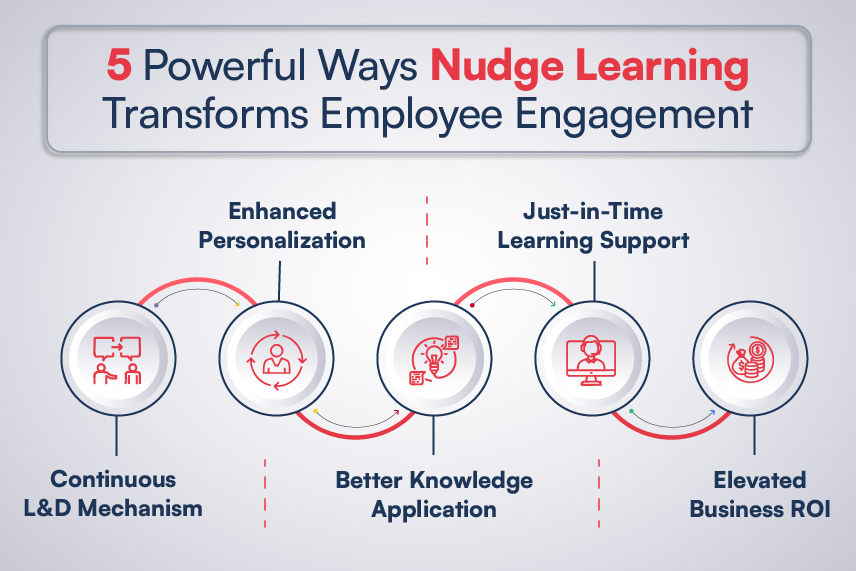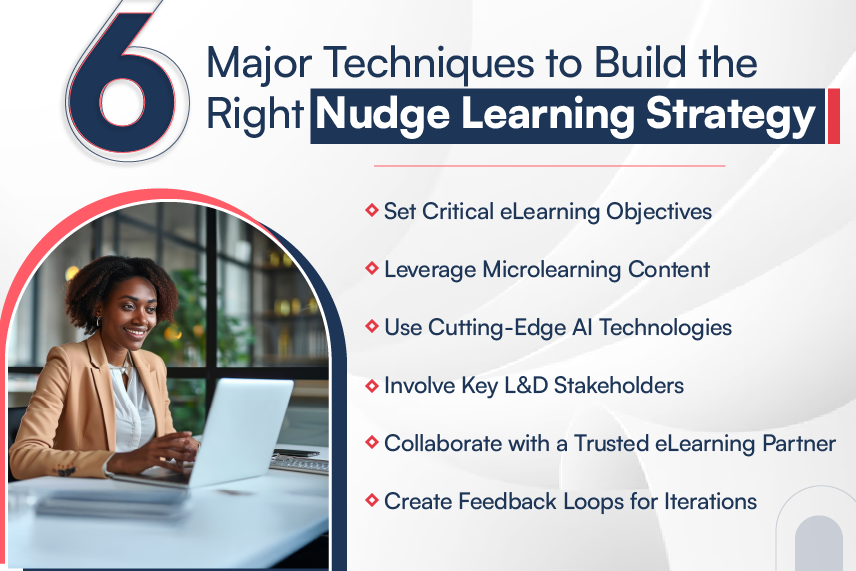
Learning can play several roles – in improving morale and productivity, encouraging collaboration, as well as creating meaningful interactions in the organization for an employee – all along with gaining knowledge. Workplaces too are looking to accommodate the changing needs of employees, enabling them to learn in a format they prefer. On that note, a gentle push, i.e., a nudge, telling the learners of a knowledge possibility can become the foundation of a great workplace learning program. Nudge Learning can simplify retaining knowledge and deliver big returns, thus increasing the impact of the learning.
How Does Nudge Learning Play its Part?
The nudge theory proposes that by shaping an environment through positive reinforcement and indirect suggestion, one can influence the behavior and decision-making of an individual. In digital learning, nudges are messages and nuggets that make learners aware of the learning resources available to them. These nudges can be personalized based on the learner’s profile and learning needs.
Learners today have a very short attention span. As a result, their learning needs to be reinforced at regular intervals for longer knowledge retention. The Ebbinghaus Forgetting Curve is a good memory model to learn more about this. It shows that close to 60% of the knowledge is lost in less than an hour of learning it.

One of the key reasons for this occurrence is the lack of reinforcement. The curve shows how quickly we forget information over time if we do not attempt to retain it. To counter this, L&D professionals need to consider nudging learners periodically with reinforcement training material to improve knowledge retention.
How Nudge Learning Improves Employee Engagement
Nudge learning enhances employee engagement by delivering small, actionable, and competency-based nudges. It enables effective skill development with periodic training resources reinforcement. Here’s how learning nuggets boost employee engagement in corporate eLearning environments.

1. Continuous L&D Mechanism
Nudge learning implements bite-sized learning content in corporate eLearning setting at regular intervals. It keeps employees connected with the training modules without disrupting their daily routines. With nudge learning, L&D professionals can create an uninterrupted learning culture and ensure proactive knowledge retention.
2. Enhanced Personalization
Nudges can be tailored to individual roles, preferences, and learning needs. They reduce information overload and promote focused eLearning. With nudge learning, L&D teams can deliver custom eLearning content with context-specific reminders. This improves employee participation, engagement, and experience.
3. Better Knowledge Application
Nudge learning can subtly influence positive actions and decisions over time. It enables regular prompts to reinforce desired behaviors, aligning with organizational goals. This gradual reinforcement bridges the gap between learning and real-world application. L&D innovators can utilize the capabilities of AI-powered microlearning nuggets to deliver learning in the flow of work.
4. Just-in-Time Learning Support
Nudge learning provides access to information when employees need it most. It enables immediate problem-solving to boost on-the-job performance. Targeted nudges provide faster and timely guidance to build trust and reduce dependency on others. They create a sense of autonomy and competence that takes employee engagement to the next level.
5. Elevated Business ROI
Learner-centric nudges maximize the impact of L&D programs. They promote regular learning reinforcement and avoid overheads related to traditional eLearning modules. With nudge learning, L&D visionaries can minimize downtime while ensuring consistent upskilling across the workforce. This will not only drive higher productivity but also improve business outcomes.
Best Practices for Creating and Delivering Nudges
Here are some of the best practices to get started with nudge learning:
1. Use short, crisp, micro-content such as videos, infographics, and short modules from existing eLearning courses as nudges. These need to be visually interesting and delivered in a timely manner for reinforcing information.
2. Curate content from the ones easily available on the web such as TED Talk videos, YouTube videos, articles, and infographics. Content curation would make a larger library of content quickly available to the employees based on their existing needs.
3. Connect the nudges with an end goal. Google’s well-known “whisper courses” were all about nudging the managers with bite-sized content to foster a psychologically safe team culture. That said, nudges work as short refreshers. They need to be able to answer specific questions when required by the learners.
4. Use the right system to deliver nudges. One needs a system more than a traditional LMS to deliver nudges. LMS has traditionally been used to manage and deliver courses across the board. However, a nudge learning platform can address learning personalization by better understanding and acting on the learner’s behavior and learning needs. Such platforms observe individual learning patterns, identify skill gaps, and accordingly push nudges based on individual performance.
How is Nudge Learning Delivered?
Personalized nudge learning can be delivered in various ways based on the organization’s preferences. Typically, these are the three popular formats:
- Mobile apps which can nudge learners depending on their individual preferences
- Learning chatbots that act as digital personal trainers
- Emails or other collaboration tools such as Microsoft Teams and Slack
As the learner performs certain actions within the nudge learning application, such as reading an article, watching a video, or taking a short module, the system observes the learner’s patterns and tracks data.
For example, to study ‘presentation styles’, a learner may be learning by watching videos on the different presentation styles. Once the learner has learned about presentation styles, the nudge learning system delivers key points or takeaways from the topic of ‘presentation styles’ at a set frequency. With the help of these nudges, the learner remembers the main points for a longer time.
Nudge learning is effective for not only retaining what a learner has already learned but also what a learner wishes to learn. Depending on the learner’s persona and the skill one is looking to acquire, the nudge learning system can pick the right nudges based on curated content and meta tags and nudge the learner to learn that particular skill over a period of time.
Such recommendations are possible due to:
- A detailed competency map based on the role of the learner in the organization
- A large library of curated content based on the skills required
- A large library of microlearning nuggets mapped to the competencies that can track the learner’s actions and can be nudged regularly based on the learner’s performance
There’s more that nudge learning can achieve. According to a LinkedIn Workplace Learning Report, 35% of L&D professionals are looking for new ways to boost learner engagement. Imagine the role nudge learning can play in gently influencing employee behavior towards a positive, skill-supported function.
Culture Amp, the employee experience platform, uses this technique for its employee feedback process. The company’s platform administrators notify all managers when their reports are ready to be viewed. Those managers who do not open their results report within one week of being notified are sent automatic nudges of their report access.
Best Practices for Implementing Nudge Learning in Corporate Training
Now that you know how nudge learning is delivered, it’s time to explore the essential steps to effectively implement this approach within your organization. Here are some practical tips to integrate nudge learning into your corporate eLearning programs.

1. Define Critical eLearning Objectives
Clearly outline the key eLearning goals to ensure your L&D program aligns with organizational needs. Establish measurable outcomes that reflect how your nudge learning approach targets workforce training and skill development. Prioritize the most crucial competencies to offer learner-centric nudges.
2. Leverage Microlearning Content
Break down training modules into concise, digestible segments to better deliver nudges when required at scale. Tailor microlearning to address specific skills or tasks relevant to immediate needs of employees. Allow learners to access learning content on-demand, anytime and anywhere.
Harbinger helped a top-tier eLearning solutions provider develop microlearning tutorials to streamline online test preparation. We broke down lengthy tutorials into structured microlessons with dedicated storyboard and media asset development. Our microlearning solution enabled targeted nudges, enhanced learner engagement, and enabled device-agnostic eLearning.
3. Use Cutting-Edge AI Technologies
Incorporate AI technologies like NLP, GenAI, and LLM that can help L&D professionals adapt training content based on individual preferences. Use ML algorithms to analyze learner behavior and personalize nudges accordingly. This will help automate reminders and prompts to encourage timely engagement with eLearning modules.
4. Involve Key L&D Stakeholders
Engage L&D leaders early on in the planning and implementation of a nudge learning strategy. Leverage their expertise to fine-tune your approach for maximum impact. Gather actionable insights to customize learning nudges that focus on continuous upskilling and reskilling.
5. Collaborate with a Trusted eLearning Partner
Partner with an experienced custom eLearning technology and content solutions provider with expertise in nudge learning and its integration into corporate training. This will help optimize the development of learning journeys, adopt advanced technologies, enable spaced learning, and create app-based nudges to future-proof L&D.
6. Create Feedback Loops for Iterations
Gather regular feedback from learners to assess the effectiveness of your nudges. Use surveys, focus groups, and employee performance data to refine the learning content. Analyze user engagement metrics to identify repetitive patterns and refine your nudge learning strategy.
Nudge Learning for Impactful eLearning
As mentioned earlier, nudge learning focuses on positive reinforcement to guide an employee’s learning skills. It encourages them to make purposeful choices, in the form of subtle interventions, thus engaging them in the learning process.
Harbinger has extensive experience in creating microlearning nuggets for anywhere, anytime learning. We have helped many organizations implement nudge learning and help organizations achieve business objectives by making learning effective.
Our nudge learning-friendly instructional design approach helps curate the optimum amount of information available and creates bursts that can be consumed just in time.
Harbinger has also developed the nudge learning platform SprinkleZone to help organizations deliver nudges of knowledge. With spaced nudges, learners can receive personalized reinforcements at specific intervals. This helps them overcome the challenge of the knowledge-forgetting curve.
If you have any questions on nudge learning, and how you can implement it in your organization, feel free to write to us at contact@harbingergroup.com. Our eLearning experts will be happy to help you.






